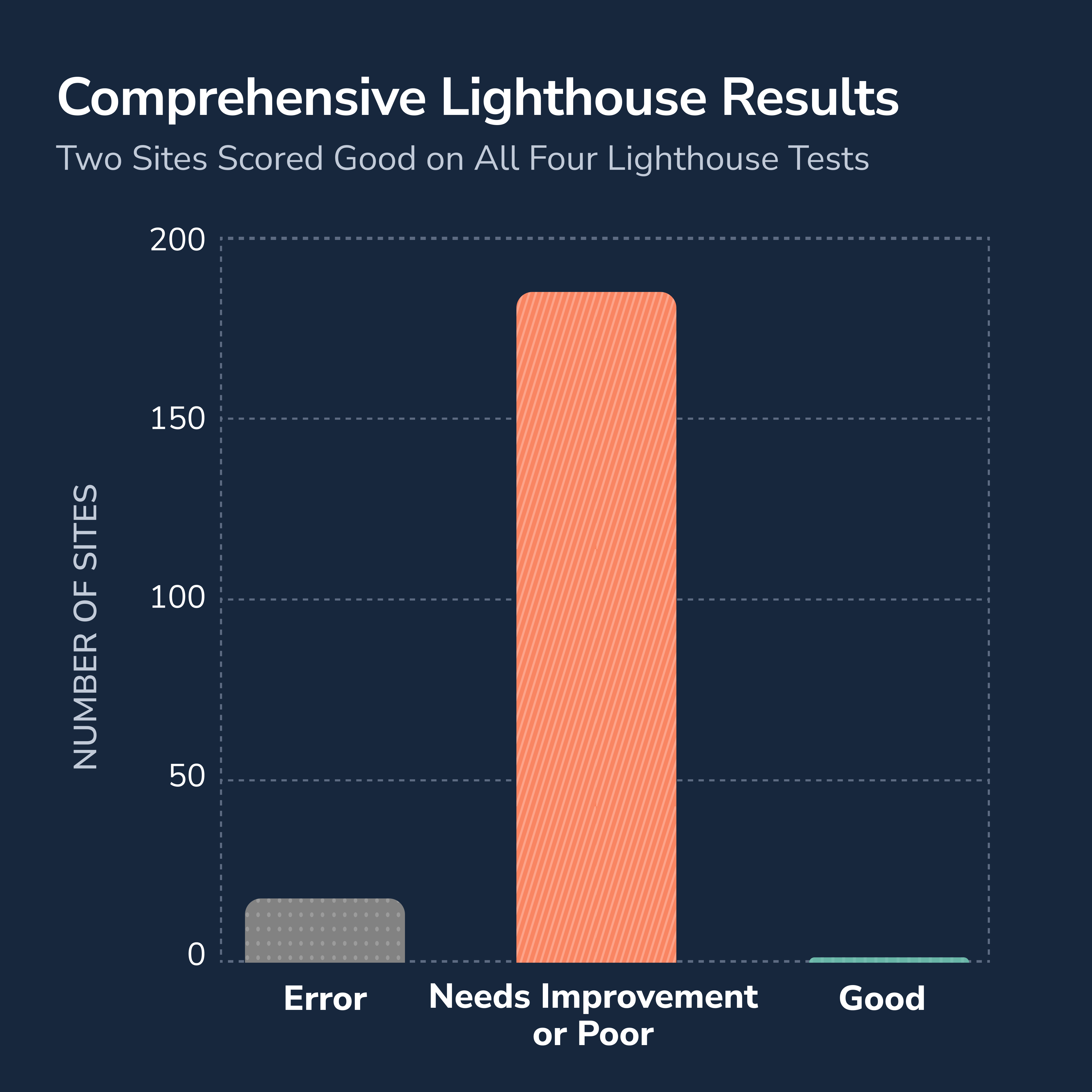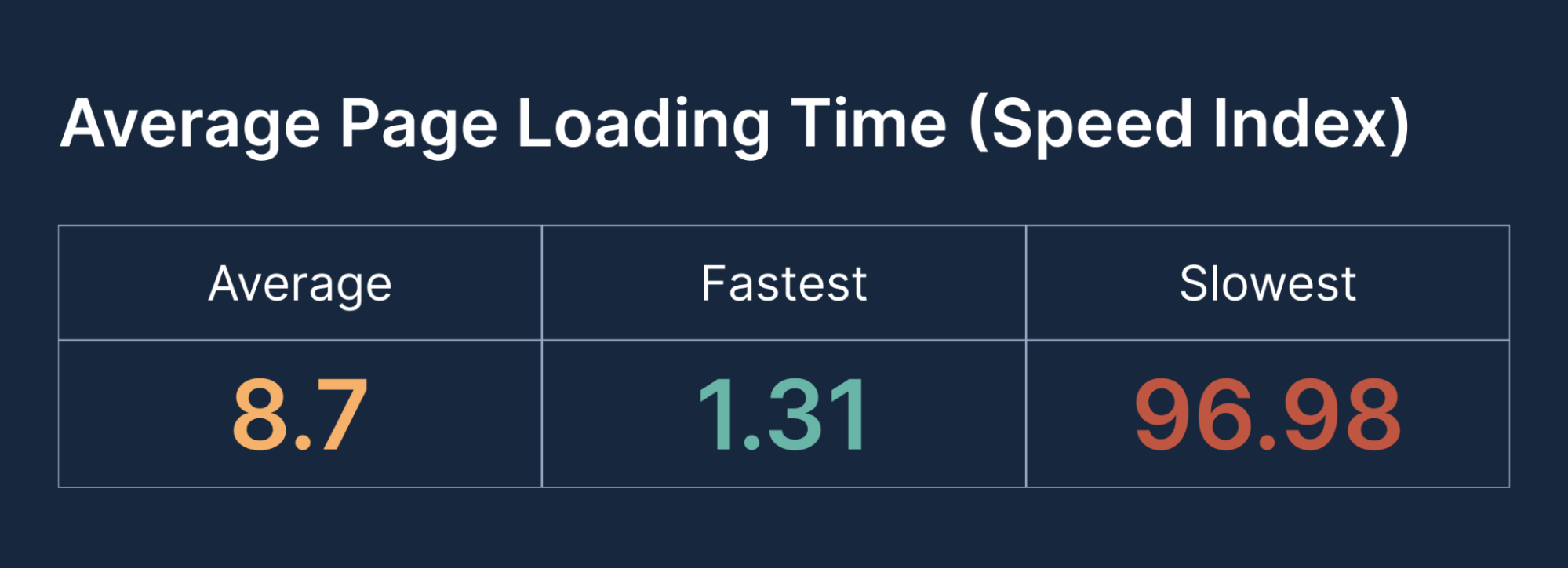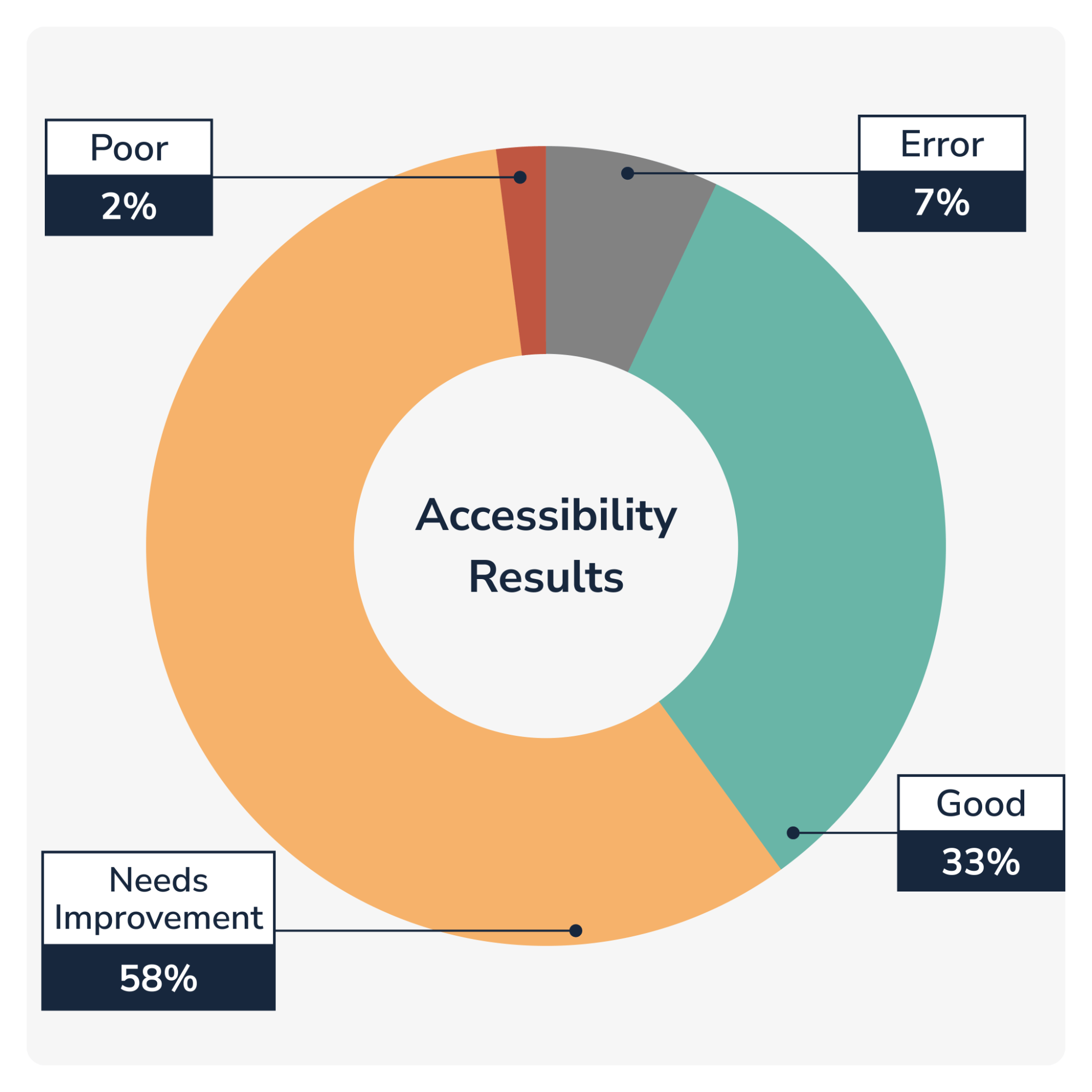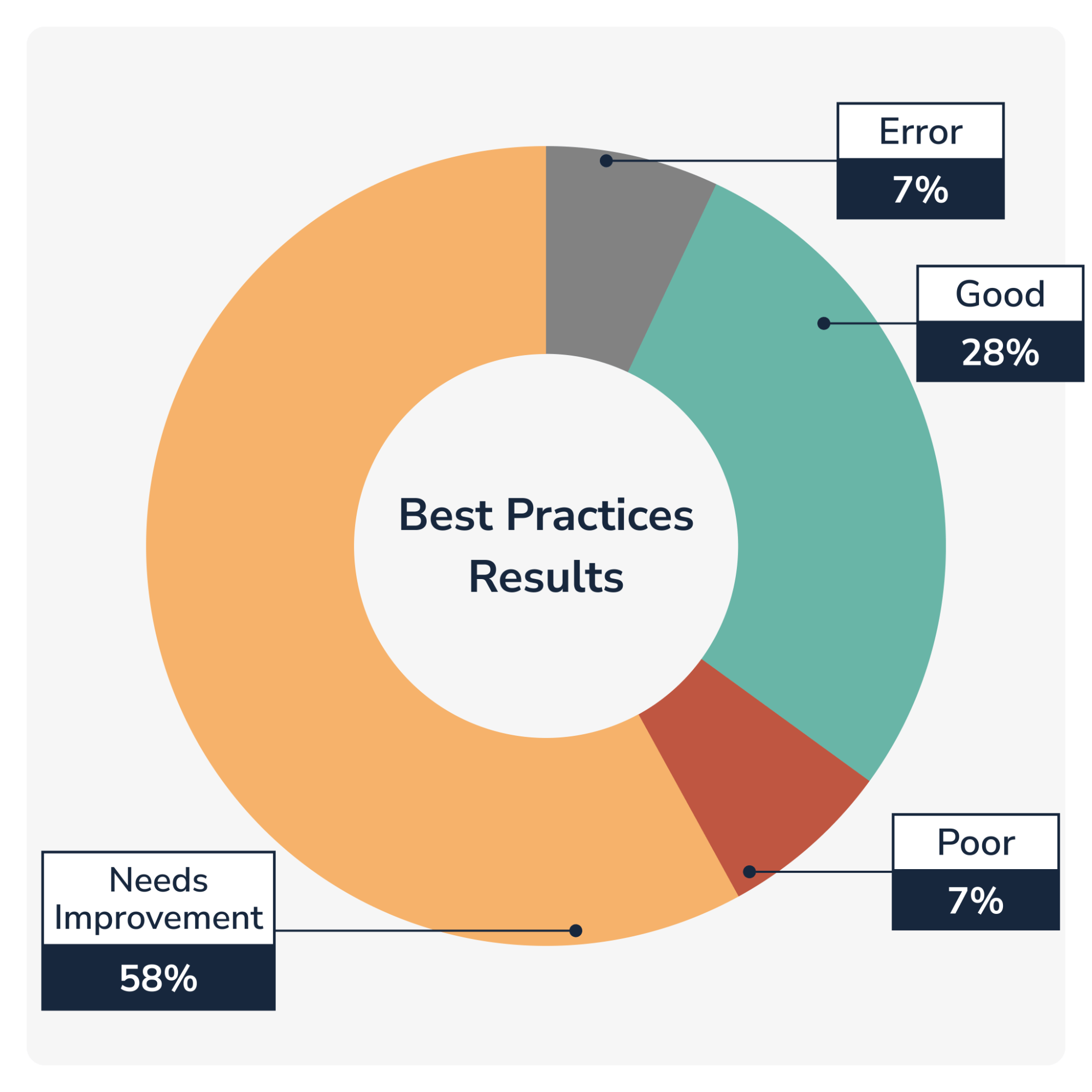

Speed Matters: Automation Engineering Websites Lag in Vital Performance Test
Key Takeaways
- Out of 200 automation engineering websites tested, only 2 websites achieved a “Good” score within Google’s performance thresholds.
- Page loading time offers a significant opportunity for improvement. Over 75% of the websites took longer than 4 seconds to load.
- The findings highlight the need for automation engineering firms to upgrade website performance, accessibility, and security for better user experience and marketing success.
A recent audit of website performance has exposed a startling gap in web standards within the competitive automation engineering industry.
In an audit of 200 company websites, only two achieved "Good" scores in Google's four critical Lighthouse tests—Performance, Accessibility, Best Practices, and SEO. The tests score sites on a scale of 0 to 100 using various criteria.
 The results raise serious concerns about the digital opportunities these firms are leaving on the table in today's tech-driven market.
The results raise serious concerns about the digital opportunities these firms are leaving on the table in today's tech-driven market.
DBS Interactive's analysis reveals that most websites in this sector are significantly underutilized for what they do best: lead generation and brand positioning.
Speed is critical to user experience and higher search engine rankings for automation engineering websites. Website users have come to expect an elevated standard of user experiences, and potential clients in the engineering industry also value a quality site's efficiency and responsiveness.
While 22 websites achieved “Good” ratings in the Performance test (meaning they scored over 90) there were 67 sites that scored “Poor” with scores below 50.
One site even scored a 7.
Performance (Page Speed) Score Highlights
- 92% of sites had scores indicating Poor or Needs Improvement
- None of the sites scored a perfect 100
- The average Performance score was 59
- About half of the sites “Need Improvement”
The Performance component of Google Lighthouse tests evaluates how quickly a webpage loads and becomes interactive for users. It checks things like how quickly the content appears on the screen (First Contentful Paint), how smoothly everything loads (Speed Index), and how soon you can start clicking and interacting with the page (Time to Interactive).
Performance measures different parts of the loading process to ensure that websites load quickly and work well for users.
Most automation engineering websites need help improving this metric, considering their load times and performance scores often fall below optimal levels (the average Performance score was 59, and the median was 56).
Milliseconds Matter
While design aesthetics are important, they should not come at the expense of performance. Studies by Google and other major tech companies confirm that users have less patience for slow-loading websites.
 Page loading times faster than 4 seconds are considered good. Of the automation engineering sites tested, 141 had speeds slower than that, with 115 forcing users to wait more than 6 seconds.
Page loading times faster than 4 seconds are considered good. Of the automation engineering sites tested, 141 had speeds slower than that, with 115 forcing users to wait more than 6 seconds.
One site took nearly 100 seconds to load, and the next closest site loaded in about 31 seconds.
Akami, the cloud computing company, found that conversion rates can drop by 7% for every 100 millisecond delay in load time. That’s a lot of lost business opportunities.
Steve Fowler, Marketing Director at DBS Interactive, emphasizes that achieving a score in the "Good" range with a well-balanced website is crucial for attracting and retaining visitors.
"More often than not, your website is how your brand is introduced on a global stage with prospects or potential talent," said Fowler. "It's also the critical touchpoint that maintains strong relationships with customers and partners. We all know this, and yet the study shows businesses are still failing to prioritize the quality of their online experience, which only limits their growth and brand awareness."
In the competitive landscape of automation engineering, where companies vie for attention and credibility, a fast and responsive website can make a substantial difference.
AutoAnything, an e-commerce subsidiary of AutoZone, is often cited as a relevant example. Website developers cut page load times in half, increasing conversions by nine percent.
Studies by Google confirm that users have little patience for slow-loading websites. Google Analytics shows that the probability of a user bouncing or leaving a website immediately increases by 32% as page load times go from 1 second to 3 seconds.

Studies show that the likelihood of a user converting decreases as page loading time increases.
Drawing parallels to successful cases in other industries, such as AutoAnything's notable increase in conversions through faster page load times, highlights the potential benefits of prioritizing website performance in the automation engineering sector.
In the automation engineering sector, where precision and innovation define the brand experience, a fast-loading website plays a pivotal role in reinforcing this narrative. A website that loads quickly creates a positive first impression and communicates a brand story centered on efficiency, innovation, and customer-centricity.
The analysis of automation engineering company websites reveals a pressing need for speed, performance, and overall user experience improvement. By prioritizing these aspects and leveraging websites as powerful marketing tools, companies in this sector can enhance their online presence, attract quality leads, and distinguish themselves in a competitive market landscape.
Errors Prevented Testing
Several sites could not complete the battery of Google Lighthouse tests. These are designated as errors in the graphics and the list of results. There are numerous possible reasons for the testing failure.
- Slow server response time
- Unoptimized images or resources
- JavaScript and CSS render-blocking
- Large page size
- Lack of caching mechanisms
- Broken or incorrect links
- Accessibility issues
- Deprecated HTML/CSS/JavaScript features
- Inefficient code execution
- Cross-origin resource sharing (CORS) issues
Accessibility Red Flags
The DBS study found that 58%, of automation engineering websites, excluding the sites with errors, scored between 50-89 for accessibility, landing them in the "Needs improvement" category. And, including the sites with “Poor” scores, the percentage of sites that failed accessibility testing jumped to 91%. 
Just as page speed is crucial for user experience, website accessibility stands equally essential for ensuring inclusivity and usability for all visitors. The concerning trend of inadequate accessibility scores among automation engineering websites highlights the pressing need for improvement.
Scores of 89 or below indicate areas needing improvement to meet the needs of users with disabilities or impairments, which may be temporary or age-related. These sites generally have inadequate keyboard navigation options or other accessibility-related shortcomings.
Although not entirely inaccessible, they fall short of meeting the optimal standards for providing a user-friendly experience for individuals with disabilities. Improving these areas can enhance inclusivity and usability for a broader spectrum of users.
An accessible website is vital in enabling all users to navigate and interact with the site effectively. This includes individuals with age-related vision impairments, hearing difficulties, or motor skill challenges.
Cyndi Masters, Owner and CEO of DBS Interactive, expressed astonishment at the disparity, noting, "Accessibility isn't a feature, it's a fundamental aspect of user experience. Ignoring accessibility is like locking doors to your website for many potential users, not to mention limiting your visibility with search engines."
The usability of a website not only enhances the overall user experience but also influences organic search rankings and pay-per-click ad performance, similar to the impact of page speed performance.
John Golden, Director of Development at DBS Interactive, pointed out common accessibility issues across industries, such as images missing Alt Text, poor color contrast, and inaccessible form controls.
Moreover, low accessibility scores can raise legal concerns, particularly regarding compliance with the Americans with Disabilities Act (ADA).
The ADA mandates accessible websites just as it requires physical places to be accessible. Recent lawsuits against significant companies underscore the importance of ADA compliance, with standards like WCAG 2.1 AA criteria serving as benchmarks for accessibility best practices.
Among 67 websites that achieved "Good" accessibility scores, 7 earned perfect scores of 100.
Benefits of an Accessible Website
- Improved search engine performance
- Positive brand reputation
- Faster user experience
- Improved user pathways
- Attracts and serves a broader audience
- Reduced legal exposure
Any Lighthouse Accessibility score below 90 means the website’s lack of accessibility could make it the target of a lawsuit.
Credibility and Security at Risk
One of the key aspects of the Best Practices test is its emphasis on web standards and optimization techniques, including security.
It encourages developers to follow recommended practices for building efficient, secure, and user-friendly websites. 
For example, it checks if the website uses modern web technologies and standards, such as responsive design for mobile devices and accessibility features for users with disabilities.
The best practices test discovered 45 sites were not built to current standards for security.
The sites did not use the Hypertext Transfer Protocol Secure (HTTPS), leaving websites and users vulnerable.
HTTPS ensures a secure and encrypted connection between a user’s web browser and the website. It adds an extra layer of protection to the information sent and received.
“Given the risks of hacking and ransomware, sites must safeguard company security and user confidence,” Golden said.
Beyond that risk to the digital architecture, a site without HTTPS often deters visitors from accessing the site and results in high bounce rates and a negative impression of a brand. Modern browsers display warnings to users, alerting them that their connection is not secure.
Visitors may question the credibility of the site, and, by extension, the company’s ability to handle sensitive information. That’s a cost that can’t be easily calculated.
Overall, 65% of the sites did not meet the broader Best Practices criteria. 
In addition to HTTPS, the Best Practices section of the Lighthouse audit evaluates whether the site has secure outbound links, updated JavaScript libraries and APIs.
Additionally, the test examines other essential practices such as specifying the HTML doctype and ensuring images are displayed at the correct resolution.
Looking at the results, Golden said he’s seen firsthand the risks associated with weaknesses identified in low Best Practices scores.
The Mobile Experience Matters
Another finding in the study revealed two websites incorporated the Progressive Web App (PWA) technology.
As more users access websites from mobile devices, performance optimization becomes essential. Google Lighthouse evaluates a website's performance on mobile devices, emphasizing the need for responsive design and efficient loading times to cater to the growing mobile user base.
Websites built as PWAs are faster, more responsive, and capable of performing like an app, yet they can still be indexed for organic search and are usable as a traditional website. The architecture of a PWA supports a better user experience.
PWA Benefits
- Fast loading time
- Operates on poor networks
- Small development footprint
- Integrates app-like features
- No app stores, no downloads
- Instant updates
Plant managers, operations, and CEOs likely begin exploring automation engineering with a search on Google, Bing, or other search engines. In addition to keywords, the consequences of poor website performance, as indicated by low Lighthouse scores, hold substantial weight in search engine rankings.
It could be the deciding factor between ranking within the top three organic search results or fading into obscurity among countless other online offerings.
SEO training company Backlinko, using Google data, found that less than 1% of users scroll much beyond the top 10 search results.
The negative effects of low performance scores on search engine signals such as page speed and accessibility contribute to elevated bounce rates and ineffective keyword content strategies.
Companies must prioritize website optimization to improve their organic search performance and gain a competitive edge in the digital landscape. The Lighthouse SEO test assesses factors such as meta tags, mobile-friendliness, crawlability, and content quality.
“Your website is often the first impression people have, and with more users turning to search engines for home health services, nailing website performance is a game-changer, said Steve Fowler, Director of Marketing at DBS Interactive.
While Google Lighthouse does not directly evaluate all aspects of SEO, elements such as meta tags, structured data markup, and mobile-friendliness are important for organic search performance. Websites that follow SEO best practices are more likely to rank higher in search results and attract organic traffic.
Engineering firms with low-performing websites face a competitive disadvantage as they struggle to attract visitors and stand out from competitors in the home health industry.
Optimizing PPC Impact for Automation Engineering Websites
The effectiveness of digital advertising campaigns is linked to a company's website performance. For automation engineering firms, leveraging paid digital advertising to enhance visibility and attract potential clients is a common strategy.

Almost 75 percent of automation engineering websites need improvement
However, without an optimized website, these efforts may result in wasted ad budgets and missed opportunities for driving conversions.
Data from the DBS study indicates that many automation engineering websites, particularly those using digital advertising, exhibit performance issues that demand improvement.
"Improving website performance is key for successful digital ad campaigns, Fowler said. Adding that “enhancing site performance boosts both organic and PPC results."
Google's evaluation of user experience extends to websites linked to PPC campaigns, influencing the Quality Score of ads.
The Impact of Low Quality Scores
Lower Ad Placement: Websites with low Lighthouse scores may be displayed lower on the search engine results page (SERP), reducing visibility and click opportunities.
Increased Cost per Click (CPC): Google rewards advertisers with higher Quality Scores by offering lower CPCs. Low scores can lead to higher costs per click, affecting overall campaign budget efficiency.
Reduced Ad Extension Impact: A suboptimal website experience limits the effectiveness of ad extensions, diminishing their impact on ad visibility and user engagement.
Lower Impressions and Click-Through Rates (CTR): Websites with poor performance scores may generate fewer impressions and a lower click-through rate (CTR), affecting the overall effectiveness of PPC campaigns.
An optimized website provides users with an exceptional experience and contributes to better ad performance, including higher conversion and reduced bounce rates.
Steve Fowler, Marketing Director at DBS, emphasizes the broader impact of website optimization beyond paid ads, stating, "Optimizing your website is like giving it a turbo boost in the race for search engine rankings."
Optimization of a website’s performance enhances user experience, and maximizes the impact of PPC campaigns, ensuring that ad budgets are utilized effectively to drive meaningful results and conversions for automation engineering companies.
Poor scores present opportunities for automation engineering firms to implement website performance improvements. Companies can document the results of the effort by tracking improved search rankings, higher click-through rates, and Lighthouse scores.
“It’s an investment that benefits visitors and the bottom line,” she said.
Capitalize on Opportunities from Lighthouse Testing Scores
The findings from the recent audit of automation engineering websites underscore the need for improvement in various areas, including website performance, accessibility, best practices, and SEO. Enhancing these areas can lead to a better user experience and notably impact organic search engine rankings, brand perception, and overall digital performance.
Given the complexities involved in optimizing websites to meet modern standards, seeking professional help can be invaluable. Companies can benefit from consulting with experts in website development, SEO, and digital marketing to address deficiencies and implement best practices effectively.
These professionals, with expertise in development, design, and strategic digital marketing, can provide insights and solutions for automation engineering firms' unique needs and goals.
Investing in website performance is about meeting standards, delivering exceptional user experiences, driving conversions, and achieving sustainable growth in today's tech-driven world.
Contact us about ways to improve the performance of your automation engineering website.
About the Website Study
DBS Interactive, a full-service digital agency in Louisville, Ky., reviewed 201 websites for automation engineering companies across the United States.
The sites were selected based on low and high annual sales using Thomas®.
The results match previous studies of industrial company websites, indicating that a lack of adherence to best practices is common.
Evaluations were done on the mobile component of the Lighthouse tool. For organic search rankings, Google and other search engines consider lighthouse scores in the test’s mobile option over desktop browsers.
Automation Engineering Sites Tested
DBS Interactive selected these companies for testing using Thomas®. In the Google Lighthouse audit tool, websites scoring between 90 and 100 are considered good performance. Scores ranging from 50 and 89 NEED IMPROVEMENT, and scores from 0 and 49 are considered POOR. Here are simple instructions for running Google Lighthouse.
Download this sheet to track your website Lighthouse scores against competitors
Read More
>> Unlocking the Benefits of High Best Practices Scores in Lighthouse
>> Unlocking Success With a High Lighthouse Performance Score
Marketing